The world's most valuable radish
 Jennifer Booher/Alamy
Jennifer Booher/AlamyAt Oaxaca's Night of the Radishes, freshly dug radishes are elaborately hand-carved for a holiday competition like no other in the world.
The radishes grown for La Noche de Rabanos (The Night of the Radishes) in Oaxaca, Mexico, are a world away from the small, thin, red and white sliced radishes that are commonly found alongside lime wedges and bowls of salsa on the tables of most taco restaurants in Mexico.
In fact, most of the 20 tonnes of giant, overfertilized radishes harvested in the days leading up to Christmas aren't edible. Instead, they're used as artist's canvases and hand-carved into the most intricate and elaborate festive scenes for a competition like no other in the world.
For the event, which is held annually on 23 December and is celebrating its 126th edition this year, the competition countdown for hundreds of Oaxacans begins with the radish harvest on the morning of 19 December, just four days before final designs are judged and a winner is chosen.
Sharpened knives, worn shovels, pointed picks and thick gloves are loaded into the backseats of cars headed for El Tequio Forest, a vast, arid expanse stretching across one of Oaxaca's many mountainous valleys. Intensive droughts this year have made the ground particularly hard, and the texture of the dry earth is closer to sand than soil.
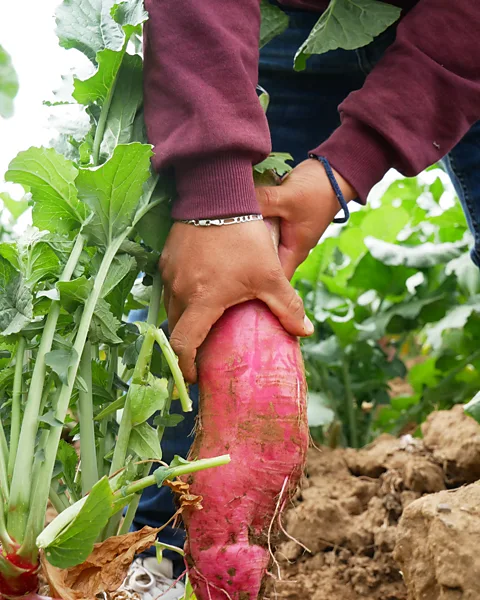 Mirja Vogel
Mirja VogelBut just beneath the craggy surface around the forest's northern tip, rows of ripe, bulbous radishes, which have become an indispensable part of Oaxaca's festive calendar for more than a century, lie ready to be harvested.
"They're bigger, heavier and uglier than ever this year," Senorino Martinez told me excitedly as we jaunted over to his field. Martinez has headed up Oaxaca's radish farming for the celebration for more than 30 years.
From a few metres away, we could make out the crimson crowns and thick red stems of 20 tonnes of giant radishes breaking through the cracked ground.
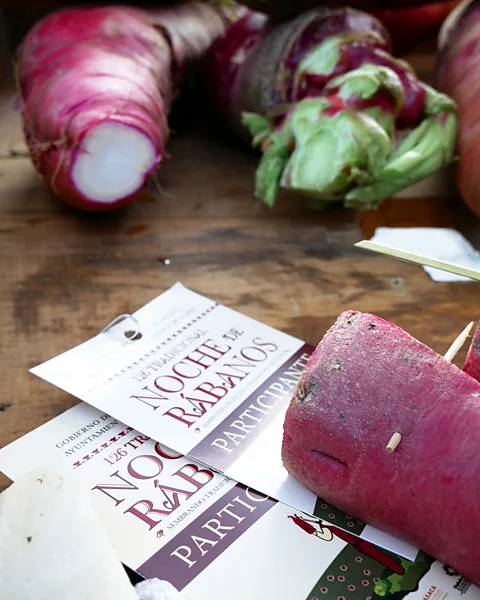 Mirja Vogel
Mirja Vogel"The artisans will cut these into shapes and sizes you would never have thought possible," he remarked as he nodded to the youngest farmer, Sergio, who planted his feet around a peaking plant and began to wrestle a bloated radish the size of my forearm from the soil.
"There will be hundreds more in all shapes and sizes… more than ever this year to keep up with the demand of the Night of the Radishes," Martinez said, before adding: "One of them is gonna make someone a lot of money too."
While Mexico is home to famous festive celebrations, including Christmas Posadas and Three Kings' Day, there are arguably none more unusual than Oaxaca's La Noche de Rabanos.
The ritual dates to the late 19th Century, when Oaxaca's market vendors would hustle for buyer attention in the Zocalo, the city's main plaza, by creatively exhibiting their seasonal produce to Christmas shoppers. In search of an edge over competitors, they'd cut their fruits and vegetables into eye-catching displays in the hope of making an extra sale.
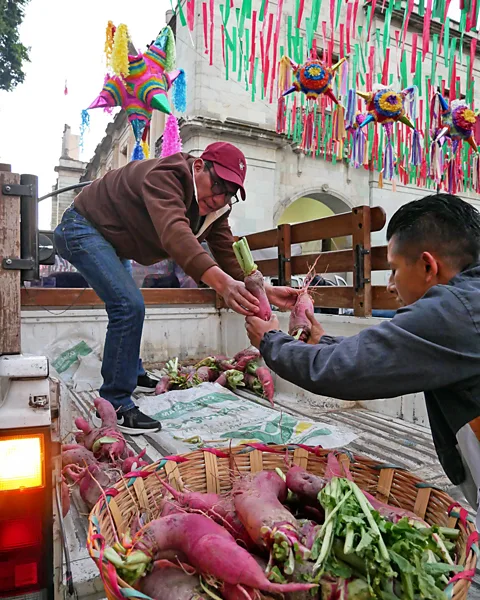 Mirja Vogel
Mirja VogelThis marketing technique became a ritual, which in turn became a Christmas tradition, and by 1897, a radish-carving competition for locals in Oaxaca was announced by the municipality's president.
Today, the radish festival's cultural roots remain very much intact. Early on the morning of 23 December, Oaxaca's main plaza is transformed into an exhibition space. Shortly after the wooden stalls are transported in, competitors begin the pulse-raising process of constructing their designs at first light, before their sculptures are formally judged by mid-afternoon. The slightest mistake at this crucial stage can mean disaster.
Artistic pride, year-long bragging rights and more than 120,000 Mexican pesos (around £5,500) are on the line for the best designs, which are decided by an esteemed judging panel made up of politicians, previous winners and artists, who will award the grand prizes at 18:00.
According to Oaxaca State's head of tourism, Saymi Pineda Velasco, "The unique pieces created for the event represent the worldview of the Oaxacan people. It brings us all together in solidarity and is one of our most significant and beloved traditions."
 Mirja Vogel
Mirja VogelFor regular participants, like Antonio Aquino, a young artisan who has entered the competition every year since 2015, planning starts soon after the end of the previous competition.
Disappointed at not being named in the top three last year, Aquino was already sketching designs for this year's competition on Christmas Day last year. "It's always important to think about what is possible in the time given and to have the right level of ambition," he said.
Despite his considerable knowledge of the competition, he said, "Experience is all relative."
There are other competitors, like Serafin Munoz, who have participated nearly every year of their lives. Munoz is a "competition legend", according to Sol Figueroa, a local resident who has attended the festival since she was young.
 Mirja Vogel
Mirja Vogel"He entered for his 55th consecutive year last year," she told me, as she excitedly scrolled through selfies of her with a variety of radish-based carvings. "He made a traditional Oaxacan brass band that was so detailed and creative, but he only got second prize, losing out to Karla Vasquez's interpretation of a regional summer fete."
Munoz told me how he remembers "learning and watching" his mother and father carve their designs in the 1960s. Following in their footsteps, he now relies on the trusted assistance of his son and grandson to help him realise his ambitious designs every year.
Vasquez hopes for the same success she achieved in 2022 when she took first prize. "I'm equally nervous and concentrated as I was last year," she said as she delicately reattached a piece of radish to her design, while her sister held her breath.
As night draws in, brass bands joyfully lead hundreds of locals and tourists in rhythmic, high-tempo dances across the Zocalo. Red and green fireworks erupt in the night sky while young children ignite handheld sparklers around the bustling crowds.
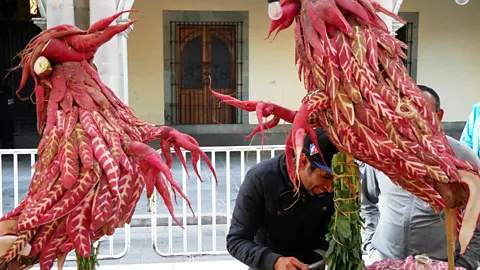 Mirja Vogel
Mirja VogelWhile bottles of beer are passed from person to person with cheers and smiles, other families carry their radish sculptures back home as their night comes to a close. The tireless work of Oaxaca's artisans will be displayed on mantelpieces and outside homes for a few more hours before the white radish flesh begins to turn brown and the once-firm structures that were carved earlier in the morning begin to soften.
In 24 hours, they'll be only good for compost, from which a new crop of radishes can grow the next year.
The winning design will be the talk of the town. And for those participants who were unsuccessful, early musings about how to take first prize next year will be underway before the Christmas feast begins.
---
Join more than three million BBC Travel fans by liking us on Facebook, or follow us on Twitter and Instagram.
If you liked this story, sign up for The Essential List newsletter – a handpicked selection of features, videos and can't-miss news delivered to your inbox every Friday.
